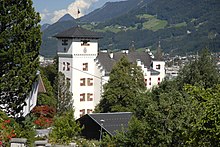Sigmundslust Castle
The Sigmundslust Castle (sometimes also written Siegmundslust ) is located in the municipality of Vomp in the Schwaz district in Tyrol (Gröben 53).
History of the castle
The castle was built in the 15th century as a square residential tower , which was built between 1472 and 1473. Originally it was one of the seven hunting castles of Archduke Sigismund the Rich in Coin ; In addition to Sigmundslust, he also owned the castles Sigmundsburg in Fernsteinsee , Sigmundsegg near Finstermünz , Siegmundsfried in Schwaz , Sigmundsruh in Sulzberg (Oberallgäu) , Sigmundsried in Ried in the Oberinntal , Hasegg Castle in Hall and Sigmundskron near Bozen . Because of his mismanagement - he had already pawned parts of Tyrol and the foreland to Bavaria through his wastefulness - he had to cede his property to the Archduke and later Emperor Maximilian I at the urging of the Tyrolean estates . The Archduke had fathered more than fifty illegitimate children, but no legitimate heir in either of his marriages. The first line of the Tyrolean Habsburgs ended with him .
Just one year after the Archduke's death, Blasius Hölzl bought the property in 1496. The next in the long line of owners was the keeper of Schwaz in 1500 , Hölzl's later father-in-law Peter Ruml von Lichtenau († 1519); he had risen to the council and house treasurer of the Archduke Sigmund and to the council of the emperor Maximilian. He also had the castle renewed before 1500. In 1515, Emperor Maximilian I enfeoffed Blasius Höltzel again with Sigmundslust. Around 1520–1526, the next owner, the rich and later ennobled Schwazer Handwerke Jörg Stöckl, set up Tyrol's first print shop in the castle; In addition to humanistic works by Josef Pirnsieder, the “Hymnarius” was printed here, the first Catholic hymn book in German. In 1532 the castle came into the possession of the Westner family and in 1581 Sigmundslust came to the (C) Kastner. Rochus Kastner built the castle chapel in 1582 with the ribbed vault that still exists today . His successor, Johann Matthias Castner, took possession of Wolfsegg Castle through marriage and acquired Traunegg Castle from 1643 and Hehenberg Castle from 1680 . The Castner was followed by Hieronymus Stauber around 1600. In 1692 the castle came to the Fieger von Hirschberg counts, who named themselves after the Sigmundslust residence .
In the Tyrolean wars of freedom against Napoleon Bonaparte in 1809, the cities of Schwaz and Vomp were destroyed by conflagrations. The French-Bavarian troops also set fire to Sigmundslust Castle. Only the lowest walls with late Gothic building elements and the castle chapel survived the fire. In 1859 the von Riccabona family bought the castle ruins and had it rebuilt and rebuilt by the architect Leopoldo De Claricini in the historicizing style. In 1862 a stair tower was added. The paintings from this period and the interior have largely been preserved. The knight's hall on the third floor is decorated with a cycle of pictures by Johannes Huber from the 19th century depicting the medieval owners of Sigmundslust. In 1890, the former imperial and royal ambassador to the courts of Siam , China and Japan , Baron Rüdiger von Biegeleben, who came from a Hessian family, acquired Sigmundslust Castle. Around 1900 he had the interior of the castle redesigned, set up a library stocked with 3000 books and brought several works of art from Japan (including samurai armor and Japanese weapons) here. A vaulted hallway with paintings by Anton Kirchmayr dates from the 20th century. Rüdiger von Biegeleben was followed by Maximilian Freiherr von Biegeleben (* January 17, 1886; † September 23, 1976). In 1997, Hans Pöll acquired the property and had the facade and inner courtyard renovated in 2000/2001.
Sigmundslust Castle today
The castle rises on a terrace directly above Vomp. It consists of a square residential tower with corner cores that date from the beginning of the 15th century. The tower in front of it was only built in the 19th century. The stepped gable facing south, a far protruding corner bay, the entrance tower in the northwest and the chapel with a small turret to the east are striking. An iron-studded "one-man door" is embedded in a round arched door that is placed over a corner. The castle is shaped by the neo-Gothic redesign in the 19th century. The property is surrounded by a crenellated wall.
In the 20th century, the von Biegeleben family used the castle as a guest house. The castle is now privately owned, the Pöll family's private foundation is housed here. Viewing is only possible from the outside.
literature
- Georg Clam Martinic : Castles and palaces in Austria . Landesverlag in Veritas Verlag, Linz 1991, ISBN 3-85214-559-7 .
Individual evidence
- ↑ Archduke Sigmund the Coin Rich (1439–1490)
- ↑ Archduke Sigmund der Münzreich and his castles
- ↑ Biography of the hype of Zant and Lonnerstadt
- ↑ Files of Emperor Maximilian I , February 1515; Hessisches Staatsarchiv Marburg (holdings 3 Political Archives Landgrave Philipps the Magnanimous, No. 365).
Web links
- Entry via Sigmundslust Castle to Burgen-Austria
- Simundslust on Schlösserrundschau.de
- Sigmundslust residence
Coordinates: 47 ° 20 ′ 31.3 " N , 11 ° 40 ′ 47.6" E



